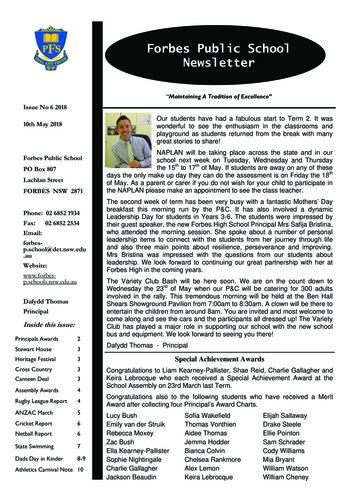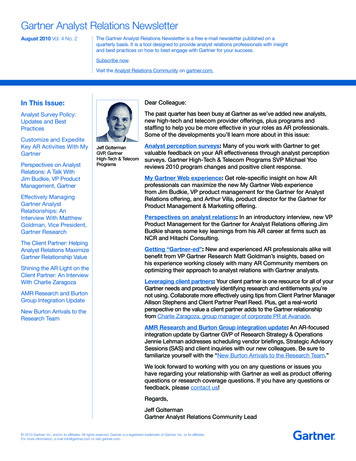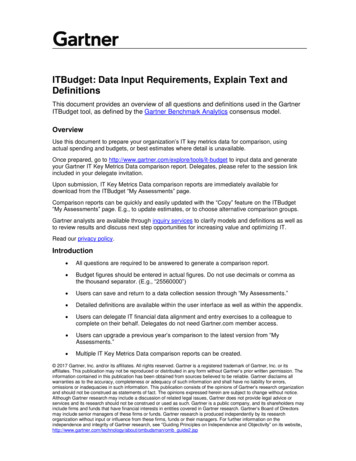
Transcription
Gartner‐Forbes C‐level Executives StudyPart IXPreparing for Growth in the Current EconomyA Day in the Life of the C‐level ExecutiveMay 2009
Table of Contents Methodology and Background Key Findings Part One: Attitudes – Preparing for Growth in the Current Economy Part Two: The Role of Information Technology in Business Strategies Part Three: Trends in Media Consumption Part Four: Demographics Part Five: Appendix2
Methodology Gartner and Forbes conducted its ninth annual C‐level Executives Study in April2009 among C‐Level and Senior Management Executives in small‐, medium‐ andlarge‐sized companies. Participants were recruited from among the Forbes Advisory Panel, as well asthird‐party partner Global Market Insite’s nationally representative online panel. The survey was fielded online by Forbes between April 21, 2009 and May 6,2009. Forbes received 658 complete responses; the results are projectable to the U.S.universe of C‐level and Senior Management Executives. 477 C‐Level Executives (80 C‐Level 1000 )(C‐Level Executives defined as:, CEO, CFO, CIO, CTO, COO, other C‐level, Board Member,President) 181 Senior Management (Excludes C‐Level)(Sr. Mgt defined as: VP/EVP/SVP, Director, Manager)3
BackgroundForbes Insights is the custom research practice of Forbes Media, publisher of Forbes magazine andForbes.com, whose combined media properties reach nearly 50 million business decision makersworldwide on a monthly basis. Taking advantage of a proprietary database of senior‐level executives inthe Forbes community, Forbes Insights’ research covers a wide range of vital business issues, includingtalent management, corporate social responsibility, financial benchmarking, risk and regulation, anddoing business in emerging markets.Gartner, Inc. (NYSE: IT) is the world’s leading information technology research and advisory company. Wedeliver the technology‐related insight necessary for our clients to make the right decisions, every day.From CIOs and senior IT leaders in corporations and government agencies, to business leaders in high‐tech and telecom enterprises and professional services firms, to technology investors, we are theindispensable partner to 60,000 clients in 10,000 distinct organizations. Through the resources of GartnerResearch, Gartner Executive Programs, Gartner Consulting and Gartner Events, we work with every clientto research, analyze and interpret the business of IT within the context of their individual role. Founded in1979, Gartner is headquartered in Stamford, Connecticut, U.S.A., and has 4,000 associates, including 1,200research analysts and consultants in 80 countries.4
Key Findings – Preparing for Growth in the Current Economy Enterprise‐size companies are more confident in their prospects for growth in the shortterm; 78% claim confidence in their prospects for revenue growth though the end of 2010,compared with 67% of small companies and 71% of medium‐sized companies– C‐level executives at Enterprise‐size companies were the most confident of all, at 84%,compared with 70% of C‐level executives in general and 71% of senior management Confidence in prospects for revenue growth increased markedly through 2012– 96% of the Enterprise C‐suite felt confident in growth prospects, compared with 88% forgeneral C‐level and 87% for Senior Management Large companies ‐‐ most particularly, the Enterprise‐size C‐suite ‐‐ are most likely to beproactively preparing strategies to be ready for the economic upturn; at 54% and 65%,respectively, compared with 45% of total respondents Enterprise‐size organizations are to be taking a wider range of actions to reduce costs inthe current recession than are SMBs ‐‐ ranging from reducing travel expenses andreducing IT staff to outsourcing more. Small companies are more likely to be taking stepsto introduce new ad campaigns and investing in digital communications.– Enterprise companies also report investing in a wider range of activities to grow their–businesses in 2009 than do SMBs, who are focusing largely on advertising.C‐level executives at enterprises also displayed the same practice of investing diversely forgrowth in 2009 when compared with C‐level executives in general and SeniorManagement5
Key Findings ‐ continued Enterprise‐size companies are also far more confident intheir sales pipelines, with 3 in 10 believing theirs are veryfull compared with 15% of total respondents– This confidence is shared by the Enterprise C‐suite, which is far more confidentthan C‐level executives in general and Senior Management Half of all respondents believe their organizations havebeen somewhat or highly impacted by the economicdownturn, a belief that transcended company size and jobtitle6
ATTITUDES: PREPARING FORGROWTH IN THE CURRENTECONOMYSection One7
Enterprise‐size companies are more confident in theirprospects for growth in the short‐ and long‐termLevel of confidence in organization’s prospects for revenue growthBy Company SizeThrough the end of 2010Through the end of 20128
The Enterprise C‐suite has the most confidence inprospects for revenue growth in the short‐ and long‐termLevel of confidence in organization’s prospects for revenue growthBy Job TitleThrough the end of 20109
Enterprise organizations are much more likely to beproactively preparing for the economic upturn, lessfocused on the current downturnAgreement with current organizational activity and focusby Company Size6 or 7 on a scale of 1‐710
Enterprise C‐level executives most proactive inpreparing for the economic upturnAgreement with current organizational activity and focusby Job Title6 or 7 on a scale of 1‐711
Enterprise organizations employing more tactics toreduce costs than SMBsTactics for reducing costs in the current recessionBy Company Size12
Enterprise C‐level executives pursuing more tactics to reducecosts, including staff reductions; C‐level in general investingmore heavily in digital communications effortsTactics for reducing costs in the current recessionBy Job Title13
Enterprise organizations making more investments forgrowth in 2009; technology, new products and hiring majorareas of focus while small businesses focus on advertisingCurrent 2009 Investments for Business GrowthBy Company Size14
Enterprise C‐suite investing for growth much more widely in2009 than other executives; new products, technology, R&D,acquisitions and hiring are top areasCurrent 2009 Investments for Business GrowthBy Company Size15
Enterprise organizations believe their pipelines arefar fuller than SMBsCurrent Sales PipelineBy Company SizeFull‐Very FullModerateEmpty16
Enterprise C‐suite most confident in sales pipeline ofall executives; more confident than Enterprise‐levelrespondents in generalCurrent Sales PipelineBy Job TitleFull‐Very FullModerateEmpty17
Despite their size, Enterprise‐level respondents areunlikely to see themselves as the industry marketleaderPerception of Competitive PositioningBy Company Size18
Enterprise C‐suite less likely to see their organizationas the industry leader than are total EnterpriserespondentsPerception of Competitive PositioningBy Job Title19
Small and Enterprise businesses see theircompetitive positioning as similarly impacted by therecessionEffect of Economic Downturn on Competitive PositioningBy Company Size20
Across job title, all see their competitivepositioning similarly affected by the economyEffect of Economic Downturn on Competitive PositioningBy Job Title21
Enterprise businesses rate customer care, brand reputation, keytalent, CSR and technological innovation above SMBs forsustaining long‐term growth in a recession; SMBs point tocustomer care and nimblenessImportance of various attributes to an organization’s competitive advantage in sustaining its growth through theeconomic downturn and over the long termBy Company SizeScale of 1 to 722
Enterprise C‐suite executives likelier to point to a range ofattributes as key to sustaining long‐term growth in a recession,including key talent, technological innovation, digital outreach,access to capital and CSRImportance of various attributes to an organization’s competitive advantage in sustaining its growth through theeconomic downturn and over the long termBy Job TitleScale of 1 to 723
Technology plays a stronger role in business strategy, plansfor growth and plans for success among large companiesThe Role of Technology in Business StrategyBy Company SizeScale of 1 to 7The Role of Technology in Business StrategyBy Job TitleScale of 1 to 724
THE ROLE OF INFORMATIONTECHNOLOGY IN BUSINESSSTRATEGIESSection Two25
26
TRENDS IN MEDIACONSUMPTIONSection Three27
Enterprise respondents use more portable devices to accessmedia during their commute; small‐business respondents morelikely to check the Internet before heading to workDaily Work Routine: Activities at the Start of the Workday and CommuteBy Company Size28
With the exception of print media, the enterprise C‐suite interactsmore with a wider range of media than do other respondents –particularly portable devicesDaily Work Routine: Activities at the Start of the Workday and CommuteBy Job Title29
Across all company sizes, the Internet is by far thesingle most important source of information onbusinessMost Important Source of Information on BusinessBy Company Size30
Across all job titles, the Internet is by far the most importantsource of information on business – though enterprise c‐suite aremore likely to turn to industry trade publications than any othergroupMost Important Source of Information on BusinessBy Job Title31
Search engines, travel, banking and bill pay are the toponline activities; Enterprise respondents engage in thewidest range of online activitiesInternet ActivitiesBy Company Size32
C‐suite and senior management highly engaged andactive onlineInternet ActivitiesBy Job Title33
Small‐ and Enterprise‐sized organizations show similar behavioronline, though small businesses are more likely to go online forintroductory product/service informationAt‐Work RoutineBy Company Size34
General and competitor research are major online activities for allrespondents, along with financial news and investing; C‐suiteturns to the web for partnership opportunitiesAt‐Work RoutineBy Job Title35
Enterprise executives – particularly in the C‐suite –consume far more media each week across allplatformsHours spent with media type per week, for work and non‐work related activitiesBy Company SizeHours spent with media type per week, for work and non‐work related activitiesBy Job Title36
All groups agree: the Internet provides the mostinformative advertising of all media channelsMedia channel providing the most informative advertising for products forbusiness or personal lifeBy Company SizeMedia channel providing the most informative advertising for products forbusiness or personal lifeBy Job Title37
SMBs rated Forbes the most‐visitedamong business sitesWebsites Visited Most Often for Business ReasonsBy Company Size38
Forbes most‐often‐visited site for businessreasons among C‐level executivesWebsites Visited Most Often for Business ReasonsBy Job Title39
Small Businesses Trust Forbes MostTrustworthiness of Online Sources for Business and Financial InformationBy Company SizeScale of 1‐540
Forbes and WSJ by far the most trustworthy amongC‐level executives and Senior ManagementTrustworthiness of Online Sources for Business and Financial InformationBy Company SizeScale of 1‐541
DEMOGRAPHICSSection Four42
Respondents by Industry43
Respondents by Company SizeOne‐quarter of respondents are employed at companies with 1,000 or more employees;50% of Senior Managers work at companies of this size44
Respondents by Region45
APPENDIXSection Five46
QuestionnaireQ1.Q2.Q3.Q4.Which of the following best describes your current employment status? Please select one response only.Which of the following best describes your job category? Please select one response only.How has the economic downturn affected your organization’s business? Please select one response only.How would you assess your level of confidence in your organization’s prospects for revenue growth through the end of2010? Please select one response only.Q5. How would you assess your level of confidence in your organization’s prospects for revenue growth through the end of 2012?Please select one response only.Q6. In terms of your organization’s current business strategy, to what extent is your organization focused on cost reduction and/orrevenue growth? Please select one response only.Q7. To what extent do you agree or disagree with each of the following statements? Please select one response only per row.Q8. What are the top 3 areas (in term of money amount spent) that you expect your organization to cut back on through the endof 2010 as a result of the economic downturn?Q9. What are the top 3 areas (in term of money amount spent) that you expect your organization to spend on through the end of2010 as a result of the economic downturn?Q10. What are your organization’s tactics for reducing costs in the current recession? Please select all that apply.Q11. Is your organization currently making or planning to make any of the following investments in 2009 in order to grow itsbusiness? Please select all that apply.Q12. How would you characterize your organization’s current sales pipeline? Please select one response only.Q13. How would you categorize your organization’s current market position within your industry? Please select one response only.Q14. How has the economic downturn affected your organization’s competitive positioning? Please select one response only.Q15. To what extent is the following happening? Please select one response only per row.Q16. To what extent is each of the following important to your organization’s competitive advantage in sustaining its growththrough the economic downturn and over the long term? Please select one response only per row.Q17. How would you categorize your organization’s use of IT? Please select one response only.47
Questionnaire, continuedQ18. Compared to fiscal year 2008, do you anticipate your organization’s need for business intelligence (BI) will decrease, stay the sameor increase in fiscal year 2009? By business intelligence, we are referring to acquiring and managing pertinent market and customerinformation.Q19. What role do you have in the technology decisions within your organization worldwide? Please select one response only.Q20. Compared to fiscal year 2008, to what extent do you expect your organization’s IT purchasing to decrease, stay about the same orincrease in fiscal year 2009? Please select one response only.Q21. To what extent do you agree or disagree with each of the following statements as they relate to technology? Please select oneresponse only per row.Q22. What does your organization plan to do more of with regard to technology as a result of the economic downturn? Select all that apply.Q23. Which of the following technologies do you see as the best investment for business growth for your organization? Please selectone response only.Q24. Thinking about your daily work routine, please indicate which of the following relate to the start of your work day and traveling towork. (Please select all that apply.)Q25. What would you consider to be your single MOST important source of information on business? Please select one response only.Q26. Thinking about your use of the Internet/Web in general, please indicate which of the following describe you. Please select all thatapply.Q27. Thinking about your at‐work routine, please indicate which of the following describe you. Please select all that apply.Q28. Thinking about your media usage habits both at work and at home, how many hours per week do you spend on each of the followingmedia, for both work and non‐work related activities? Please select one response only for each media.Q29. Which media channel do you find provides the most informative advertising regarding products for your business or personal life?Please select one response only.Q30. When you are online for business reasons, which Web sites do you visit most often? Please select all that apply.Q31. Please rate how trustworthy you believe the following online sources to be when it comes to business and financial information:Please select one response only per row.Q32. Which of the following most accurately represents your organization’s primary industry classification? If your organizationparticipates in more than one industry, please select the one industry in which you are most involved. Please select one response only.Q33. Which of the following geographic regions is your primary workplace located? Please select one response only.Q34. Which of the following ranges most closely represents the total number of employees in your organization worldwide? Your bestestimate is fine. Please select one response only.Q35. Which of the following categories represents your organization’s enterprise‐wide annual revenue (across your worldwideorganization, including all of its branches, divisions, and subsidiaries) for fiscal year 2008? Please select one response only.Q36. Compared to fiscal year 2008, to what extent do you forecast that you organization’s enterprise‐wide annual revenue will decrease,stay about the same or increase in fiscal year 2009? Please select one response only.48
Research, Gartner Executive Programs, Gartner Consulting and Gartner Events, we work with every client to research, analyze and interpret the business of IT within the context of their individual role. Founded in 1979, Gartner is headquartered in Stamford, Connecticut, U.S.A.,










